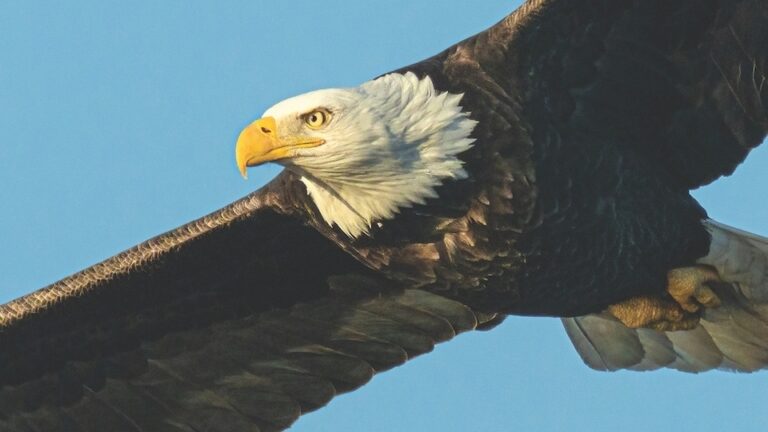
America’s Founding Fathers made a fitting choice when they settled on the bald eagle as the symbol of the country’s freedom and strength, all the more so as eaglets take flight right around the time of the Independence Day holiday.
It was not so long ago that the country’s exalted bird faced extinction, but federal intervention, including regulating the pesticide DDT and other conservation measures, as well as making it illegal to possess, kill or sell eagles, resulted in bald eagles making a comeback.
“A lot of people didn’t grow up seeing bald eagles around, and now they are fairly common,” said Brian Hess, a wildlife biologist with the Connecticut Department of Energy and Environmental Protection, who oversees the state’s bald eagle monitoring program.
“The bald eagle population across the state is good and every year we get new territories with more nesting pairs,” said Hess. “The population keeps growing and we are closing in on 85 nesting pairs” in the state.
Eagles are thriving on the Connecticut River and the DEEP recommends visiting places like the Connecticut River Museum or Gillette Castle State Park to look for them. They are also on the Thames and Pawcatuck rivers, near the Groton reservoirs, and have been spotted on the upper Mystic River, as well as inland along the Quinebaug and Shetucket rivers.
“If I was telling people where to go to spot bald eagles in southeastern Connecticut, I would start with the lower Connecticut River, from Essex south,” said Kim Hargrave, director of education at the Denison Pequotsepos Nature Center in Mystic.
“I’d also suggest the Thames River, but further north, by the Mohegan-Pequot Bridge, and near the Groton reservoirs, and the upper Mystic River. But it’s always a hit or miss thing,” said Hargrave.
When she started working at the nature center in 1989, Hargrave said organized excursions to look for bald eagles was a popular activity.
“We would do these boat trips on the Connecticut River, and seeing a bald eagle was a huge deal. If we spotted two or three, we would be so excited. But today we don’t run those programs anymore because it’s not that hard now to find bald eagles.”
Hess explained that it is a volunteer force in Connecticut that helps to keep track of the state’s bald eagles.
“We are dependent on volunteers who find the nest and report it,” he said. “When you see an eagle carrying sticks or grass, then you know there is a nest nearby.”
Eagles like to locate near a water source, a river or lake, and typically look for a sturdy tree with big openings and gaps to support their super-sized nests, which they regularly reinforce, said Hess.
They mostly feed on fish, but will grab a small mammal or a duck or goose, he said, adding, “They will eat whatever they can get their talons on.”
Hess described eagles as thieves, and said given the opportunity, they will steal fish from other birds, particularly ospreys.
They mate for life, he said, but if one dies, the other will find a new partner. Their life span is about 20 years.
A pair typically mates in the wintertime and lays eggs in late February to early March. They incubate the eggs—usually one or two—for about five weeks.
“They usually hatch the first or second week of April and leave the nest 10 to 12 weeks later. It’s right around the Fourth of July that eagles are taking flight,” said Hess.
The bald eagle comeback is a wildlife success story that Americans celebrate.
“Their story ties back to the environmental awakening that happened in the ‘60s and ‘70s; cleaning up our air and water across the nation,” said Hess. “When we cleaned up the air and our water, the species endangered in the early ‘70s benefitted.
“Collectively, we are realizing we can have a positive effect when we clean up the environment and the fact that eagles are a part of that story provides me with a lot of encouragement about conservation,” said Hess.
“Bald eagles are a symbol of our country and they are large, majestic birds,” said Hargrave, from the nature center. “This was a species on the verge of extinction and it took a long time for them to reappear in Connecticut.”
In January of each year the state conducts a survey of bald eagles. In 2021, a record was set when 125 adults and 76 immature bald eagles were spotted across 154 observation sites by 234 volunteers covering 516 miles of shoreline.
That same year, breeding eagles in Connecticut set records for active territories, successful nests, and chicks produced. Of the 80 active territories, 13 were brand new that year.
According to the DEEP, since DDT, an insecticide used in agriculture, was banned in 1972, Connecticut bald eagle nests have produced 830 chicks.
Hess understands that people want to spot bald eagles, but cautions them to keep their distance.
“They are big, charismatic and fun to watch,” he said. “They are a national pride and for a lot of people represent an example of conservation success. Enjoy the fact that they are here, but also give them space. If an animal changes its behavior because you are there, you are too close.”